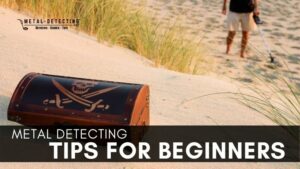The term relic hunting can be used to describe many different activities that involve the recovery of historic objects. For our purpose we will only be covering the metal detecting aspect of the term.
True relic hunters fit into a class that is much different than a coin hunter or beachcomber. Relic hunting takes a great deal of physical stamina, love of history and thorough research techniques. A true relic hunter may spend hours, days or months trying to locate that one hot spot. He may wait out the seasons to access a site once it is located. Then spend many more hours ensuring his site has been thoroughly hunted and that all finds have been preserved and cataloged.
The relic hunting tips on this page will hopefully help you become a better relic hunter. If you have a tip or trick you would like us to add you can contact us here. We are always looking for new techniques to help us improve our metal detecting and relic hunting.
Research
A relic hunters most valuable tools are his research materials, Research is king! Without the proper research techniques and materials the relic hunter is hopeless.
It only makes sense that this would be our first tip then. Good research is the first step to any successful relic hunt. For an in depth view on research visit our research page.
Tip – Walk your site before metal detecting
Always walk your site before metal detecting it. Pay close attention to the surface content, you are looking for indicators of past activities. Some of these indicators might be pottery fragments (Sherds), old glass, large foundation stones, brick fragments etc…
By the time you are done walking your metal detecting site you should have a pretty good idea of where to begin your hunt.
Relic Hunting River Sites
River hunting is in a class of its own, but because most early civilizations were formed around waterways there is a good chance you will find yourself metal detecting along or in close proximity to a river at some point in your journey’s.
Metal detecting a river is much like metal detecting a beach in that erosion and soil deposits due to water flow and weather conditions will dictate where the goods will be found. I have found gravel bars and cuts to be the best area and have trained myself to stay away from mud flats. Again much like a beach you’re not going to detect a gold ring that is buried under 3′ of sand the same applies to these mudflats.
When I was a beginner metal detector and relic hunting, I would search these areas without much success. Finding a beer can buried under 3′ of mud and sediment is not uncommon, so you can just imagine how deep the musket balls and colonial silver are. There are exceptions to every rule and by all means take full advantage if you are faced with one. One exception would be an area where the sediment and mud are eroded away and the hard pack is almost exposed
Good practice, as always is to do a walk of an area before turning your metal detector on.
Preservation and Documentation
Any good relic hunter will also do his or her best to preserve and document all of his or her finds. There is some good software available for doing this read about it here.
Many objects found while relic hunting are of historic significance and should be treated as such. Please don’t toss historical finds into a corner because they carry no value you to. If you find something that is historical and is worth nothing to you please donate those finds to someone that will give them the attention they deserve!
Relic Hunting Checklist
Because relic hunting will usually take you off the beaten path you need to go prepared. Make a checklist of all items you may need out in the field. Some of these items may include the following. Metal detectors, shovels, maps, compass or GPS, extra batteries, food, drink….. It sounds like a lot, but believe me it’s better to be safe than sorry. If you’ve ever been 3 miles back in the woods and had your batteries die with no backups you know just what I’m talking about. Do yourself a favor and make a complete checklist!

